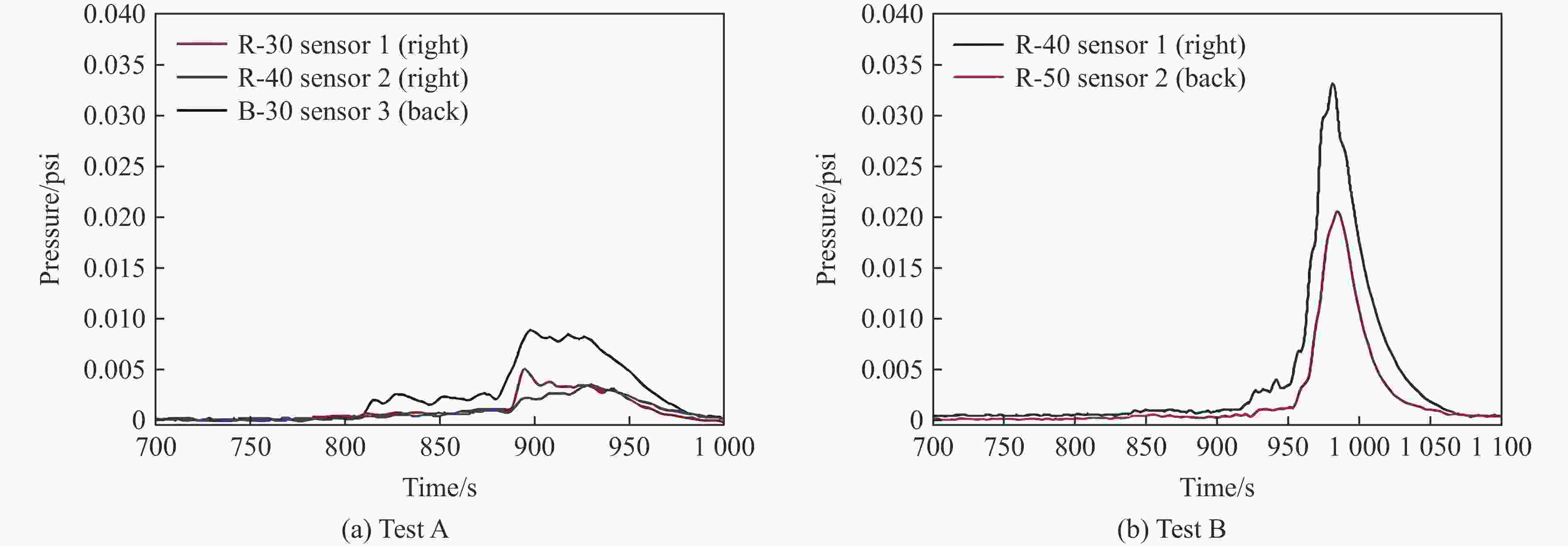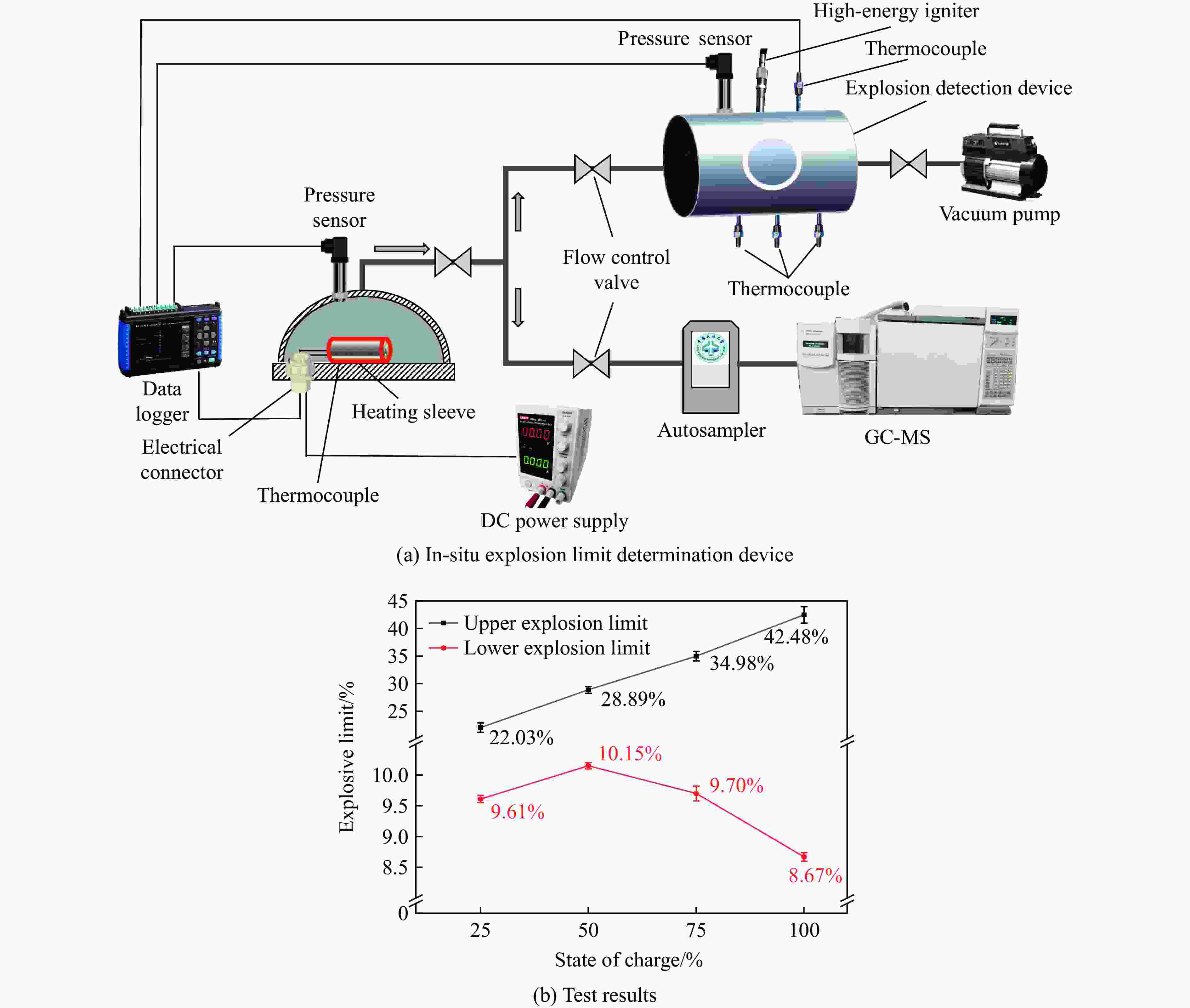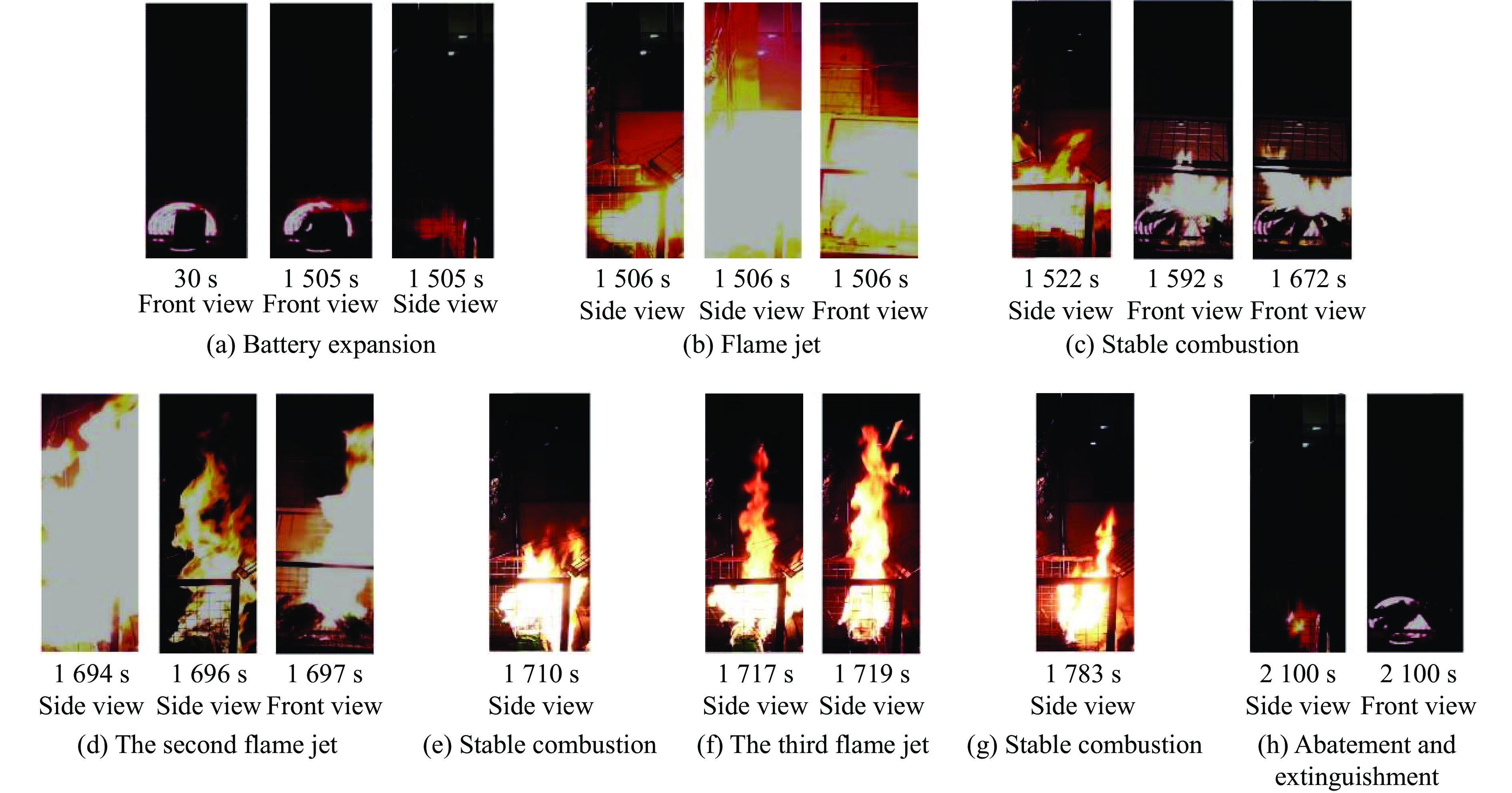| [1] |
黄俊, 杨凤田. 新能源电动飞机发展与挑战 [J]. 航空学报, 2016, 37(1): 57–68. DOI: 10.7527/S1000-6893.2015.0274.HUANG J, YANG F T. Development and challenges of electric aircraft with new energies [J]. Acta Aeronautica et Astronautica Sinica, 2016, 37(1): 57–68. DOI: 10.7527/S1000-6893.2015.0274.
|
| [2] |
XU J J, CAI X Y, CAI S M, et al. High-energy lithium-ion batteries: recent progress and a promising future in applications [J]. Energy & Environmental Materials, 2023, 6(5): e12450. DOI: 10.1002/eem2.12450.
|
| [3] |
FENG X N, REN D S, HE X M, et al. Mitigating thermal runaway of lithium-ion batteries [J]. Joule, 2020, 4(4): 743–770. DOI: 10.1016/j.joule.2020.02.010.
|
| [4] |
国家市场监督管理总局, 国家标准化管理委员会. 电动汽车用动力蓄电池安全要求: GB 38031-2020 [S]. 北京: 中国标准出版社, 2020.State Administration for Market Regulation, Standardization Administration. Electric vehicles traction battery safety requirements: GB 38031-2020 [S]. Beijing: Standards Press of China, 2020.
|
| [5] |
FENG X N, OUYANG M G, LIU X, et al. Thermal runaway mechanism of lithium ion battery for electric vehicles: a review [J]. Energy Storage Materials, 2018, 10: 246–267. DOI: 10.1016/j.ensm.2017.05.013.
|
| [6] |
杨娟, 胡佳宁, 佟佳成, 等. 航空锂电池热失控高温喷射冲击实验研究 [J]. 航空学报, 2024, 46(14): 430965. DOI: 10.7527/S1000-6893.2024.3096.YANG J, HU J N, TONG J C, et al. Experimental study on high-temperature jet impact induced by thermal runaway in aviation lithium-ion batteries [J]. Acta Aeronautica et Astronautica Sinica, 2024, 46(14): 430965. DOI: 10.7527/S1000-6893.2024.3096.
|
| [7] |
ZHAO W Y, GUO Z X, MA Z C, et al. Coupled effect of low temperature and electrolyte immersion on the tensile properties of separators in lithium-ion batteries [J]. ACS Applied Materials & Interfaces, 2023, 15(35): 41783–41792. DOI: 10.1021/acsami.3c05450.
|
| [8] |
GUO Z X, YANG S G, ZHAO W Y, et al. Overdischarge-induced evolution of Cu dendrites and degradation of mechanical properties in lithium-ion batteries [J]. Journal of Energy Chemistry, 2023, 78: 497–506. DOI: 10.1016/j.jechem.2022.12.013.
|
| [9] |
PING P, WANG Q S, HUANG P F, et al. Study of the fire behavior of high-energy lithium-ion batteries with full-scale burning test [J]. Journal of Power Sources, 2015, 285: 80–89. DOI: 10.1016/j.jpowsour.2015.03.035.
|
| [10] |
PING P, KONG D P, ZHANG J Q, et al. Characterization of behaviour and hazards of fire and deflagration for high-energy Li-ion cells by over-heating [J]. Journal of Power Sources, 2018, 398: 55–66. DOI: 10.1016/j.jpowsour.2018.07.044.
|
| [11] |
张青松, 郭超超, 秦帅星. 锂离子电池燃爆特征及空运安全性研究 [J]. 中国安全科学学报, 2016, 26(2): 50–55. DOI: 10.16265/j.cnki.issn1003-3033.2016.02.009.ZHANG Q S, GUO C C, QIN S X. Study on lithium-ion batteries explosive characteristics and aviation transportation safety [J]. China Safety Science Journal, 2016, 26(2): 50–55. DOI: 10.16265/j.cnki.issn1003-3033.2016.02.009.
|
| [12] |
YANG J, LIU W, ZHAO H, et al. Experimental investigation of lithium-ion batteries thermal runaway propagation consequences under different triggering modes [J]. Aerospace, 2024, 11(6): 438. DOI: 10.3390/aerospace11060438.
|
| [13] |
CHEN S C, WANG Z R, YAN W, et al. Investigation of impact pressure during thermal runaway of lithium ion battery in a semi-closed space [J]. Applied Thermal Engineering, 2020, 175: 115429. DOI: 10.1016/j.applthermaleng.2020.115429.
|
| [14] |
CHEN M Y, OUYANG D X, LIU J H, et al. Investigation on thermal and fire propagation behaviors of multiple lithium-ion batteries within the package [J]. Applied Thermal Engineering, 2019, 157: 113750. DOI: 10.1016/j.applthermaleng.2019.113750.
|
| [15] |
ZOU K Y, CHEN X, DING Z W, et al. Jet behavior of prismatic lithium-ion batteries during thermal runaway [J]. Applied Thermal Engineering, 2020, 179: 115745. DOI: 10.1016/j.applthermaleng.2020.115745.
|
| [16] |
MAO B B, ZHAO C P, CHEN H D, et al. Experimental and modeling analysis of jet flow and fire dynamics of 18650-type lithium-ion battery [J]. Applied Energy, 2021, 281: 116054. DOI: 10.1016/j.apenergy.2020.116054.
|
| [17] |
CHEN S C, WANG Z R, LIU J H. A semi-quantitative analysis of infrared characteristics of thermal runaway ejection behaviour of lithium-ion battery [J]. Journal of Energy Storage, 2023, 71: 108166. DOI: 10.1016/j.est.2023.108166.
|
| [18] |
张青松, 翟祺悦, 赵子恒. 受限空间锂离子电池热解气体燃烧释能研究 [J]. 消防科学与技术, 2021, 40(12): 1711–1714. DOI: 10.3969/j.issn.1009-0029.2021.12.002.ZHANG Q S, ZHAI Q Y, ZHAO Z H. Study of energy release from pyrolysis gas combustion of Li-ion battery in confined space [J]. Fire Science and Technology, 2021, 40(12): 1711–1714. DOI: 10.3969/j.issn.1009-0029.2021.12.002.
|
| [19] |
任常兴, 蒋乐章, 王玥, 等. 高温高压条件下可燃气体爆炸极限测定标准对比研究 [J]. 标准科学, 2023(2): 73–77, 100. DOI: 10.3969/j.issn.1674-5698.2023.02.012.REN C X, JIAGN Y Z, WANG Y, et al. Comparative study on determination standards for the explosion limits of the combustible gas at high temperature and pressure [J]. Standard Science, 2023(2): 73–77, 100. DOI: 10.3969/j.issn.1674-5698.2023.02.012.
|
| [20] |
中华人民共和国国家质量监督检验检疫总局, 中国国家标准化管理委员会. 空气中可燃气体爆炸极限测定方法: GB/T 12474-2008 [S]. 北京: 中国标准出版社, 2009.General Administration of Quality Supervision, Inspection and Quarantine of the People’s Republic of China, Standardization Administration of the People’s Republic of China. Method of test for explosion limits of combustible gases in air: GB/T 12474-2008 [S]. Beijing: Standards Press of China, 2009.
|
| [21] |
中华人民共和国国家质量监督检验检疫总局, 中国国家标准化管理委员会. 化合物(蒸气和气体)易燃性浓度限值的标准试验方法: GB/T 21844-2008 [S]. 北京: 中国标准出版社, 2008.General Administration of Quality Supervision, Inspection and Quarantine of the People’s Republic of China, Standardization Administration of the People’s Republic of China. Standard test method for concentration limits of flammability of chemicals (vapors and gases): GB/T 21844-2008 [S]. Beijing: Standards Press of China, 2008.
|
| [22] |
中华人民共和国国家质量监督检验检疫总局, 中国国家标准化管理委员会. 化学品危险性分类试验方法 气体和气体混合物燃烧潜力和氧化能力: GB/T 27862-2011 [S]. 北京: 中国标准出版社, 2012.General Administration of Quality Supervision, Inspection and Quarantine of the People’s Republic of China, Standardization Administration of the People’s Republic of China. Testing method for classification of chemical hazards: fire potential and oxidizing ability of gases and gas mixtures: GB/T 27862-2011 [S]. Beijing: Standards Press of China, 2012.
|
| [23] |
ASTM International. Standard test method for concentration limits of flammability of chemicals (vapors and gases): ASTM E681-2009 [S]. West Conshohocken: ASTM International, 2009.
|
| [24] |
CEN. Determination of explosion limits of gases and vapours: EN 1839 [S]. Brussels: CEN, 2012.
|
| [25] |
ASTM International. Standard practice for determining limits of flammability of chemicals at elevated temperature and pressure: ASTM E918-83 [S]. West Conshohocken: ASTM International, 2011.
|
| [26] |
CEN. Determination of explosion limits of gases and vapours at elevated pressures, elevated temperatures or with oxidizers other than air: prEN 17624 [S]. Brussels: CEN, 2021.
|
| [27] |
褚英杰, 李旭朝, 陈自强, 等. 安全壳压力试验中多元混合可燃性气体的爆炸极限研究 [J]. 核科学与工程, 2023, 43(1): 151–158. DOI: 10.3969/j.issn.0258-0918.2023.01.023.CHU Y J, LI X C, CHEN Z Q, et al. The study of the flammability limits of the multicomponent gas in the containment pressure test [J]. Nuclear Science and Engineering, 2023, 43(1): 151–158. DOI: 10.3969/j.issn.0258-0918.2023.01.023.
|
| [28] |
BAIRD A R, ARCHIBALD E J, MARR K C, et al. Explosion hazards from lithium-ion battery vent gas [J]. Journal of Power Sources, 2020, 446: 227257. DOI: 10.1016/j.jpowsour.2019.227257.
|
| [29] |
BOUNACEUR R, GLAUDE P A, SIRJEAN B, et al. Prediction of flammability limits of gas mixtures containing inert gases under variable temperature and pressure conditions [C]//ASME Turbo Expo 2017: Turbomachinery Technical Conference and Exposition. Charlotte: ASME, 2017. DOI: 10.1115/GT2017-64172.
|
| [30] |
CHEN S C, WANG Z R, WANG J H, et al. Lower explosion limit of the vented gases from Li-ion batteries thermal runaway in high temperature condition [J]. Journal of Loss Prevention in the Process Industries, 2020, 63: 103992. DOI: 10.1016/j.jlp.2019.103992.
|
| [31] |
张伟, 郝朝龙, 刘添添, 等. 航空压力环境对锂离子电池热解气体爆炸极限影响 [J]. 中国安全生产科学技术, 2022, 18(11): 155–162. DOI: 10.11731/j.issn.1673-193x.2022.11.022.ZHANG W, HAO C L, LIU T T, et al. Influence of aviation pressure environment on explosion limit of pyrolysis gas from lithium-ion batteries [J]. Journal of Safety Science and Technology, 2022, 18(11): 155–162. DOI: 10.11731/j.issn.1673-193x.2022.11.022.
|
| [32] |
ZHANG Q S, NIU J H, ZHAO Z H, et al. Research on the effect of thermal runaway gas components and explosion limits of lithium-ion batteries under different charge states [J]. Journal of Energy Storage, 2022, 45: 103759. DOI: 10.1016/j.est.2021.103759.
|
| [33] |
ZHANG Q S, NIU J H, YANG J, et al. In-situ explosion limit analysis and hazards research of vent gas from lithium-ion battery thermal runaway [J]. Journal of Energy Storage, 2022, 56: 106146. DOI: 10.1016/j.est.2022.106146.
|
| [34] |
张青松, 包防卫, 牛江昊. 环境压力对锂电池热失控产气及爆炸风险的影响 [J]. 储能科学与技术, 2023, 12(7): 2263–2270. DOI: 10.19799/j.cnki.2095-4239.2023.0192.ZHANG Q S, BAO F W, NIU J H. Risk analysis method of thermal runaway gas explosion in lithium-ion batteries [J]. Energy Storage Science and Technology, 2023, 12(7): 2263–2270. DOI: 10.19799/j.cnki.2095-4239.2023.0192.
|
| [35] |
ZHANG Y J, WANG H W, LI W F, et al. Quantitative analysis of eruption process of abused prismatic Ni-rich automotive batteries based on in-chamber pressure [J]. Journal of Energy Storage, 2020, 31: 101617. DOI: 10.1016/j.est.2020.101617.
|
| [36] |
WANG Z P, YUAN J, ZHU X Q, et al. Overcharge-to-thermal-runaway behavior and safety assessment of commercial lithium-ion cells with different cathode materials: a comparison study [J]. Journal of Energy Chemistry, 2021, 55: 484–498. DOI: 10.1016/j.jechem.2020.07.028.
|
| [37] |
KIM S W, PARK S G, LEE E J. Assessment of the explosion risk during lithium-ion battery fires [J]. Journal of Loss Prevention in the Process Industries, 2022, 80: 104851. DOI: 10.1016/j.jlp.2022.104851.
|
| [38] |
SHAN T X, WANG Z P, ZHU X Q, et al. Explosion behavior investigation and safety assessment of large-format lithium-ion pouch cells [J]. Journal of Energy Chemistry, 2022, 72: 241–257. DOI: 10.1016/j.jechem.2022.04.018.
|
| [39] |
SOMANDEPALLI V, MARR K, HORN Q. Quantification of combustion hazards of thermal runaway failures in lithium-ion batteries [J]. SAE International Journal of Alternative Powertrains, 2014, 3(1): 98–104. DOI: 10.4271/2014-01-1857.
|
| [40] |
LI W F, WANG H W, ZHANG Y J, et al. Flammability characteristics of the battery vent gas: a case of NCA and LFP lithium-ion batteries during external heating abuse [J]. Journal of Energy Storage, 2019, 24: 100775. DOI: 10.1016/j.est.2019.100775.
|
| [41] |
LI W F, RAO S, XIAO Y, et al. Fire boundaries of lithium-ion cell eruption gases caused by thermal runaway [J]. iScience, 2021, 24(5): 102401. DOI: 10.1016/j.isci.2021.102401.
|
| [42] |
ESSL C, GOLUBKOV A W, GASSER E, et al. Comprehensive Hazard Analysis of Failing Automotive Lithium-Ion Batteries in Overtemperature Experiments [J]. Batteries, 2020, 6: 30. DOI: 10.3390/batteries6020030.
|
| [43] |
GOLUBKOV A W, FUCHS D, WAGNER J, et al. Thermal-runaway experiments on consumer Li-ion batteries with metal-oxide and olivin-type cathodes. [J] RSC Advance. 2014, 4: 3633–3642. DOI: 10.1039/c3ra45748f.
|
| [44] |
GOLUBKOV A W, SCHEIKL S, PLANTEU R, et al. Thermal runaway of commercial 18650 Li-ion batteries with LFP and NCA cathodes: impact of state of charge and overcharge. [J] RSC Advances. 2015, 5: 57171–57186. DOI: 10.1039/c5ra05897j.
|
| [45] |
LAMMER M, KÖNIGSEDER A, HACKER V. Holistic methodology for characterisation of the thermally induced failure of commercially available 18650 lithium ion cells. [J] RSC Advances. 2017, 7: 24425–24429. DOI: 10.1039/c7ra02635h.
|
| [46] |
ZHANG Y, WANG H, LI W, et al. Size distribution and elemental composition of vent particles from abused prismatic Ni-rich automotive lithium-ion batteries. [J] Journal of Energy Storage. 2019, 26: 100991. DOI: 10.1016/j.est.2019.100991.
|
| [47] |
张青松, 包防卫, 牛江昊. 三元锂电池热失控产气爆炸风险评估研究 [J/OL]. 电源学报, 2023-12-20 [2024-03-18]. http://kns.cnki.net/kcms/detail/12.1420.tm.20231219.1347.012.html.ZHANG Q S, BAO F W, NIU J H. Study on risk assessment of thermal runaway gas explosion of ternary lithium battery [J/OL]. Journal of Power Supply, 2023-12-20[2024-03-18]. http://kns.cnki.net/kcms/detail/12.1420.tm.20231219.1347.012.html.
|
| [48] |
杨娟, 牛江昊, 张青松. 循环老化锂离子电池热失控气体原位爆炸极限实验分析 [J]. 航空学报, 2023, 44(23): 428529. DOI: 10.7527/S1000-6893.2023.28529.YANG J, NIU J H, ZHANG Q S. In-situ explosion limit of thermal runaway gas explosion in cyclic aging lithium-ion batteries: experimental analysis [J]. Acta Aeronautica et Astronautica Sinica, 2023, 44(23): 428529. DOI: 10.7527/S1000-6893.2023.28529.
|







 下载:
下载:












